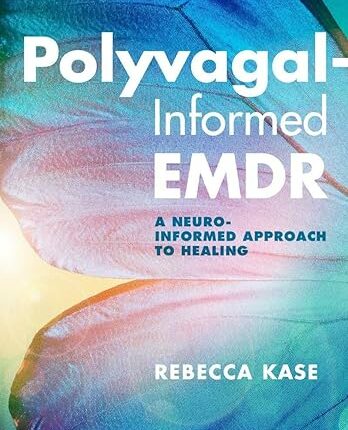PVT supercharges EMDR

The day after reading this book, I found myself trying out what I had read in a client session, and this must be the ultimate test for any book setting out a psychotherapy approach. That I was able to do this only the day after reading suggests the book is well-written and easily accessible to an EMDR practitioner. Those who attended the 2023 EMDR Association’s annual conference, where Rebecca Kase gave the keynote address, will already be aware that she can inspire her audience by describing powerful personal experiences, both as a client and a practitioner.
Kase’s book is aimed at EMDR practitioners who want to integrate polyvagal theory (PVT) into their EMDR practice. She describes PVT as explaining “the science of feeling safe and how the autonomic nervous system responds to danger.” While the importance of establishing safety in trauma therapy was discussed by Herman as far back as 1992 (Herman, J. 1992), PVT provides an elaborated physiological explanation for the primacy of safety for mental health as well as for good psychotherapy. The early treatment stages of EMDR itself include stabilisation, resource development and grounding, and PVT provides a theoretical conceptualisation for this based on human biology. Rebecca quotes extensively from Porges (Porges, SW. 2011) and Dana (Dana, D. 2018), who have led the clinical application of PVT, as well as Shapiro on EMDR (Shapiro, F. 2001). The book contains some very useful diagrams to explain the workings of the vagus nerve and the resulting states of mind and body.
While, of course, it is possible to read Porges and Dana themselves, Rebecca’s simplified synthesis will be useful to EMDR practitioners because it demonstrates how PVT can be integrated into EMDR. For instance, she describes how the working of the vagus nerve influences hyperarousal and hypoarousal, with consequent restrictions on a client’s window of tolerance. She then describes, with clinical vignettes, what kind of neural exercises might work with clients to help them regulate again. Understanding that 80% of vagus nerve fibres relay information from the body to the brain brings home the crucial importance of such exercises. This may not be new to practitioners, but it does fill in our theoretical understanding in a way that boosts confidence in our practice.
The importance of the therapeutic relationship is well known too, but again, the descriptions throughout the book of co-regulation and social engagement in the promotion of safety can only add to a clinician’s expertise. Kase quotes Deb Dana’s views on the necessity of the three ‘Cs’ in therapy: connection, context and choice, and explains how she implemented them with clients in her clinical work (Dana, D. 2018).
The emphasis of PVT on safety leads Kase to describe it as the priority in trauma work, whereas she postulates that many EMDR therapists believe in the myth that reprocessing trauma (EMDR protocol phase 4) is the thing that makes clients better. Therapists who work with complex clients, such as survivors of child abuse or torture, may feel there is some truth to this perspective, having struggled to prepare such clients for this phase. It could be said that approaches that have adapted the standard protocol, such as attachment-informed EMDR, have evolved to address the same challenge of establishing safety for very fearful clients. Kase asserts that “helping someone regulate their nervous system is priceless,” and she therefore devotes much of the book to illustrating how this can be done.
In fact, one of the most helpful chapters (Chapter 10) focuses on how to help clients regulate painful emotions during phase 4 reprocessing in EMDR. Kase uses a lengthy and detailed clinical vignette to show how she worked with a veteran to enable him to access the AIP system by developing coping skills to manage feelings that came close to overwhelming him. The distribution of lively vignettes throughout the book is an important factor in its accessibility, as practitioners often find descriptions of client work more helpful and interesting than theory.
Building on its physiological focus, the book explores how autonomic states affect a client’s narrative. As Kase puts it, quoting Dana,
The narratives we believe about ourselves, other people, and the world are shaped by the autonomic state leading the way.
In this sense, she says, negative cognition is a verbalisation of an autonomic state. When I explored this with my client, she found it helpful to understand that her thoughts did not come from nowhere but could be influenced by what was going on in her body. This empowered her to change how she was thinking by working on her autonomic state. When she calmed her breathing, she felt less frightened, and her thoughts about herself and others were more positive.
This book proposes some minor changes to the EMDR standard protocol as a result of PVT, which Kase believes can make EMDR more effective. Her writing is clear, and her message is inspiring. The book is well worth buying for an EMDR practitioner.
References
Dana D. (2018) The polyvagal theory in therapy: Engaging the rhythmn of regulation. Norton.
Herman J. (1992) Trauma and recovery: From domestic abuse to political terror. New York Basic Books.
Porges SW. (2011) Polyvagal safety: Attachment communication, self-regulation. Norton.
Shapiro F. (2001) Eye movement desensitization and reprocessing: Basic principles, protocols, and procedures (2nd. ed.). New York: Guilford Press.




